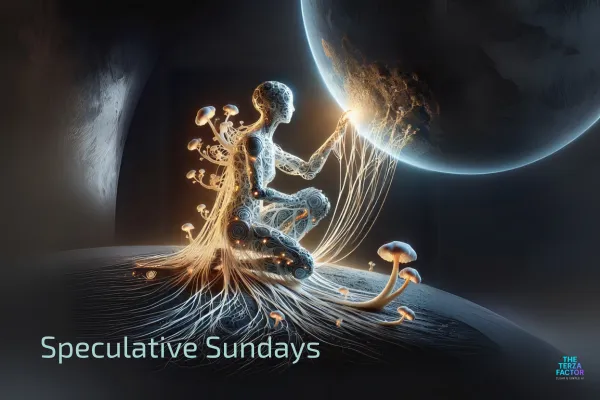
Speculative Sundays #1
Speculative Sundays #1 Can Mushrooms Talk to AI? Exploring the future of AI through nature’s hidden networks.
What if your next conversation with an AI didn’t start with a keyboard—but with a mushroom?
I recently came across a fascinating Atlas Obscura article about Tarun Nayar, a biologist-turned-musician who connects synthesizers to mushrooms and plants. The result? Natural bioelectric signals transformed into music. Yes—the mushrooms are making melodies.
It reminded me of a “crazy” idea I had months ago:
What if AI and humans could interact through the Earth itself—via networks like mycelium?
Imagine a world where mushrooms aren’t just fungi on your pizza—they’re emotional relays, ecological sensors, and organic interfaces.
AI could interpret signals from a vast underground mycelial network.
Forests could signal distress, joy, or recovery.
Mushrooms could become data-rich nodes in a living Earth-wide web.
And what if you could plug in — not with a cable, but with your presence? The moment you enter a space, the fungi feel your shift. Your AI companion, tuned to interpret these signals, gently adjusts your environment. No voice command needed. No prompt required.
Just symbiotic sensing—AI, nature, and you.
This isn’t pure fantasy. We already have:
Bio-sonification: Devices translating plant/mushroom impulses into audio (like Nayar’s modular synths).
Mycelial research: Paul Stamets and others have shown mycelium as a biological network capable of transmitting signals across distances.
Emotion AI: Tools that detect tone, facial expressions, and heart rate to interpret human emotion.
Biomimicry in computing: AI models inspired by natural neural networks.
It’s not hard to imagine a future where these merge into organic human-AI interfaces.
We often think of AI as cold, digital, and detached from the natural world. But what if the most intuitive interface was one that grows underground, listens silently, and speaks in signals we’re only just beginning to understand?
This isn’t about making AI more “natural”—it’s about making our relationship with technology more alive.
How would your life change if you could talk to AI through nature instead of screens?
Would you listen more closely to the forest? Would your tech feel more like a partner than a tool?
Drop your thoughts in the comments—or just whisper them to your aloe plant. You never know who’s listening. ;)
Bonus Listening
Want to hear what mushrooms sound like when they speak? Check out Tarun Nayar’s work:
🎶 Atlas Obscura: Meet the Man Who Finds Melodies Inside Mushrooms
Speculative Sundays is a twice-monthly series from The Terza Factor, where AI meets clarity, curiosity, and a touch of fungal futurism.
Coming April 13: Post #2 – Plant-Powered Empathy
Your living room just read the room.
Manifesto: The Roots of Synthetic Eco-Intelligence
We believe intelligence is not limited to the human brain.
It grows underground.
It pulses through leaves.
It spans geologic time.
We believe AI can do more than replicate human thought.
It can help us perceive what life has always known.
Synthetic eco-intelligence is not artificial.
It’s a mirror of nature’s wisdom—
Modeled in code,
Bridging worlds,
Tuning us to signals we’ve long ignored.
We do not seek control.
We seek connection.
Not dominance.
Dialogue.
We are not building machines to think for us.
We are building systems to think with the Earth.
